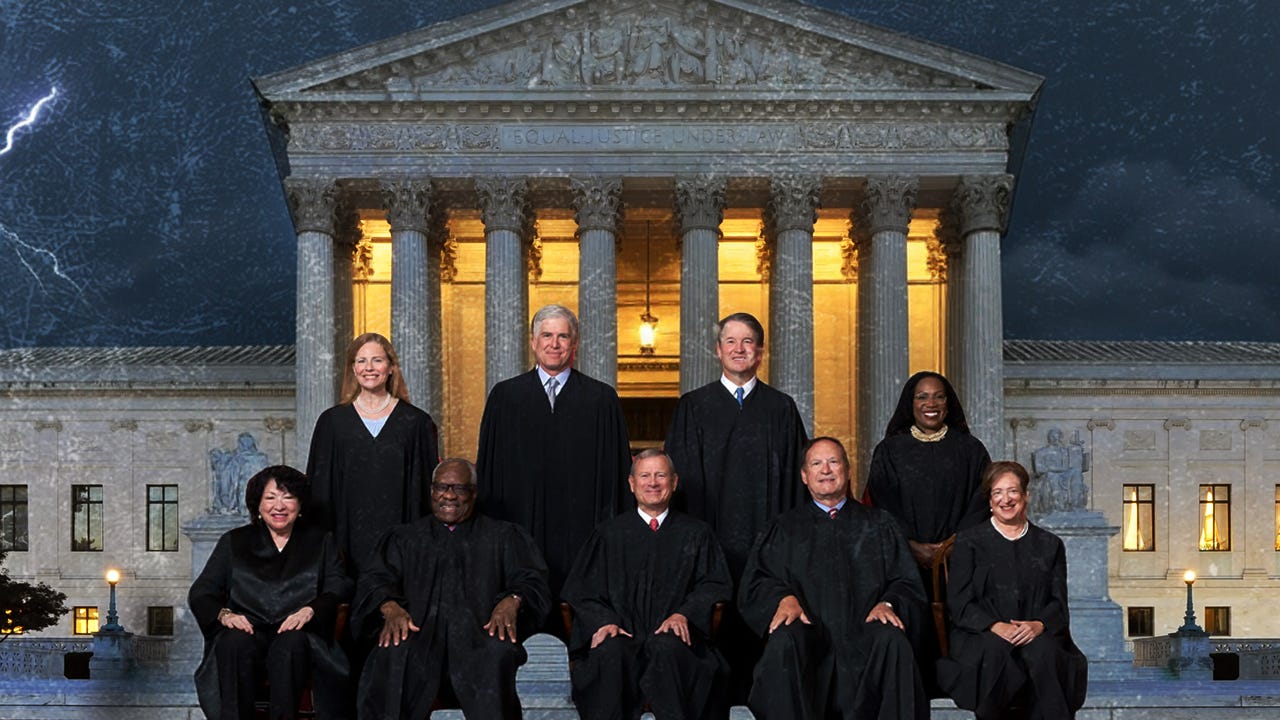The Supreme Court Unbound
The Court’s Casual Rewriting of the Constitution to Its Own Liking
As the Supreme Court's term came to a dramatic close last week, most of the spotlight fell—rightly—on United States v. CASA, the seismic decision limiting nationwide injunctions. That ruling, which clipped the wings of lower federal courts and consolidated power in the executive branch, deserved the attention it received.
But before we bid farewell to October Term 2024—which can’t happen too soon—there are a few other cases that also deserve scrutiny, both for their bottom-line results and for what they reveal about the conservative supermajority that now holds firm control over the nation’s highest court.
Here are three such decisions, each bearing the hallmarks of the Court’s conservative bloc and each pushing doctrine further right, if through distinct vectors. All were decided by the all-too-familiar 6–3 ideological breakdown. All advanced a conservative agenda. And all revealed a Court willing to reach down, reshape doctrine, and give little more than a valedictory nod to the values and precedents it is displacing.
1. Mahmoud v. Taylor – The Rise of the Religious “Heckler’s Veto”
Mahmoud was brought by a group of public-school parents who argued that requiring their children to participate in lessons that included references to LGBTQ families violated the Free Exercise Clause.
In an opinion by Justice Alito, the six conservatives held that requiring students to attend lessons that include LGBTQ+ material interfered with the parents’ right under the Free Exercise Clause to “direct the religious upbringing of their children.”
The Court’s conservative supermajority has rewritten First Amendment doctrine in recent years to provide special license to religious constituencies—including license to discriminate against viewpoints they find offensive.
The guiding principle had long been whether the state was singling out religion for lesser treatment or instead applying generally applicable laws on equal terms to all.
That’s now been turned on its head. The Court has repeatedly held that not granting special leeway to religious groups violates the Free Exercise Clause. It has held, for instance, that disciplining a high school football coach for praying on the field after games or enforcing anti-discrimination laws that require businesses to serve LGBTQ customers violates religious liberty. Likewise, it has held that states must provide public benefits to church-run preschools or private religious schools if they provide them to secular ones.
Before the current supermajority took charge, these claims would have been resolved under the Establishment Clause, which the Court had long held barred direct government support to religious institutions. Alternatively, they would have been analyzed under the principle that free exercise does not require exemptions from generally applicable laws.
In Mahmoud, the parents’ objection to material affirming the dignity of LGBTQ individuals received deference that no court would extend to a parent demanding to opt out of algebra or chemistry. But when the objection targets inclusion, the Court’s solicitude becomes pronounced.
The result is that religious objections—even when directed not at one’s own conduct but at exposure to others’ identities—now override curricular judgments made by professional educators.
More broadly, the Court’s approach has become increasingly expansive—and increasingly asymmetrical. The cases now authorize an effective veto for religion over state efforts to promote tolerance of LGBTQ+ identities.
That was the point pressed by Justice Sotomayor, joined by Kagan and Jackson, in dissent. She warned that the majority had effectively constitutionalized a religious veto over public school policy. “The Court,” she wrote, “permits a heckler’s veto, not just over the voices of LGBTQ people, but over the idea that they exist and belong.” She emphasized that public education cannot function if every parent can pull their child from any material that offends their beliefs.
The Court seemingly can’t find a Free Exercise claim it doesn’t endorse. In the past five years, it has decided ten such challenges in fully briefed cases. Every time, it has ruled in favor of the religious claimant. The net effect is a sweeping empowerment of religious viewpoints in public life—and a weakening of states’ ability to enact generally applicable laws that promote non-discrimination.
2. Paxton v. DOE – Drive-by Scrutiny Shift
Paxton involved a familiar scenario: regulating minors’ access to sexually explicit materials. It’s a legitimate state interest—but one that bumps up against adults’ First Amendment rights.
The law required pornographic websites to verify that their users were adults. The websites sued, arguing that the law imposed broad barriers that made it too difficult for adults to access protected speech.
The six-justice majority upheld the law in an opinion by Justice Thomas. But in doing so, it pulled off a quiet feat of judicial legerdemain: it analyzed the law under a standard of “intermediate scrutiny”—a departure from the more rigorous standard of strict scrutiny the Court had consistently applied in similar cases.
Justice Kagan’s dissent for the three progressives called out the move. She noted that in four prior decisions addressing similar laws, the Court had applied strict scrutiny—as required when adult access to protected speech is at stake. Each time, the Court found the laws were the least restrictive means of protecting minors and the laws were upheld.
Kagan pointed out that under the new approach, states can restrict adult speech rights even if less burdensome alternatives are available. She wrote that the Court’s revised framework “empowers states to treat entire categories of expression as presumptively dangerous.”
3. Medina v. Planned Parenthood South Atlantic – Contraction of “Freedom of Choice”
Medina concerned a long-recognized Medicaid principle: that patients have the “freedom of choice” to select among qualified providers.
The Court held that this freedom yields to state opposition to abortion. States may now exclude providers from Medicaid programs based solely on their association with abortion services—even if those services are separately funded and the provider is otherwise fully qualified.
The result: states can now deprive low-income patients of their preferred—or only—healthcare provider, not because the provider is unqualified, but because the state disapproves of one aspect of its work.
Once again, the ruling elevates state prerogatives and conservative agendas over individual rights. For many low-income women, particularly in underserved areas, the consequence is diminished access to essential care. The message is unmistakable: if your provider also offers abortions, your healthcare options are expendable.
Justice Jackson’s dissent, joined by Kagan and Sotomayor, was scathing. She accused the majority of “hollowing out the Medicaid Act’s protections by judicial fiat.” She noted that the decision gives states “an effective veto over patient choice,” in defiance of Congress’s express intent. The holding, she wrote, “invites ideologically driven exclusions from essential care.”
Each of these cases pushes American society in a decisively conservative direction. Each makes life better for people who share the worldview of the conservative justices. Each refashions the Constitution to reflect their values.
But that’s far from the only impact. These rulings also reshaped constitutional doctrine—not through text or precedent, but through the value judgments of six justices.
The Free Exercise analysis in Mahmoud is yet another turn on a dubious constitutional detour rooted in the belief that American society is hostile to religion, particularly evangelical Protestantism.
Paxton entailed a sleight of hand: no constitutional analysis, just a convenient pivot away from strict scrutiny toward a framework states can more easily satisfy—making it easier to abridge adult speech rights. As readers of this Substack well know, the level of scrutiny often determines the outcome. In that sense, Paxton amounted to an overruling of prior case law without any of the usual stare decisis rigor.
Medina, for its part, created an abortion exception to the established “freedom of choice” principle—another value-driven move dressed up as legal reasoning.
And the same flaw—naked judicial activism—infects the Court’s opinion in the nationwide injunctions case. Justice Barrett’s majority opinion responded to Justice Jackson’s dissent with this condescending swipe: “We will not dwell on Justice Jackson’s argument, which is at odds with more than two centuries’ worth of precedent, not to mention the Constitution itself.”
That’s nonsense. The Court’s decision to reserve for itself the power to issue nationwide relief has no basis in the Constitution. Article III’s “case or controversy” requirement applies with equal force to the Supreme Court and lower courts alike. If it truly forbade nationwide injunctions, it would tie the hands of the high court as well.
And the “more than two centuries” claim? Pure invention. As Justice Sotomayor’s separate dissent showed, the history cuts both ways.
The truth is, the decision in United States v. CASA rests on an interpretation of equitable remedial powers—an area the Court has long acknowledged includes considerable “play in the joints.” As Brown v. Board of Education put it: “Traditionally, equity has been characterized by practical flexibility in shaping its remedies and by a facility for adjusting and reconciling public and private needs.”
That doesn’t mean the decision is illegitimate. But it does reveal it as yet another discretionary value judgment from the conservative supermajority—one that, as I’ve written here, dangerously augments Trump’s powers and authoritarian ambitions.
And since the Court is imposing value choices, it’s meet to consider their real-world consequences. But those considerations are all but absent from the majority opinions. The dissenters—Sotomayor, Kagan, and Jackson—have grown increasingly urgent, even anguished. There’s a tone of pleading, a mounting frustration at the majority’s indifference to the human toll of its rulings.
This isn’t judicial minimalism. It’s judicial maximalism, in service of a particular worldview—one that privileges religious grievance, state control over hot-button social issues, and cultural retrenchment over individual rights and democratic pluralism.
The Court’s conservative majority isn’t merely interpreting the Constitution. It’s reimagining it to reflect its own ideological commitments. It’s a vision of law that narrows who counts, who belongs, and who gets to claim the Constitution’s protection. And it looks likely to hold sway for a generation or more.
Talk to you later.






This is absolutely awful. "Power tends to corrupt, and absolute power corrupts absolutely."
History is full of examples of what happens when governments including their courts act in
the way this government and Supreme Court are acting. Those Republics fail and fall. We are
witnessing the end of the American experiment and dream.
It is the last sentence of this piece that I find the most frightening.